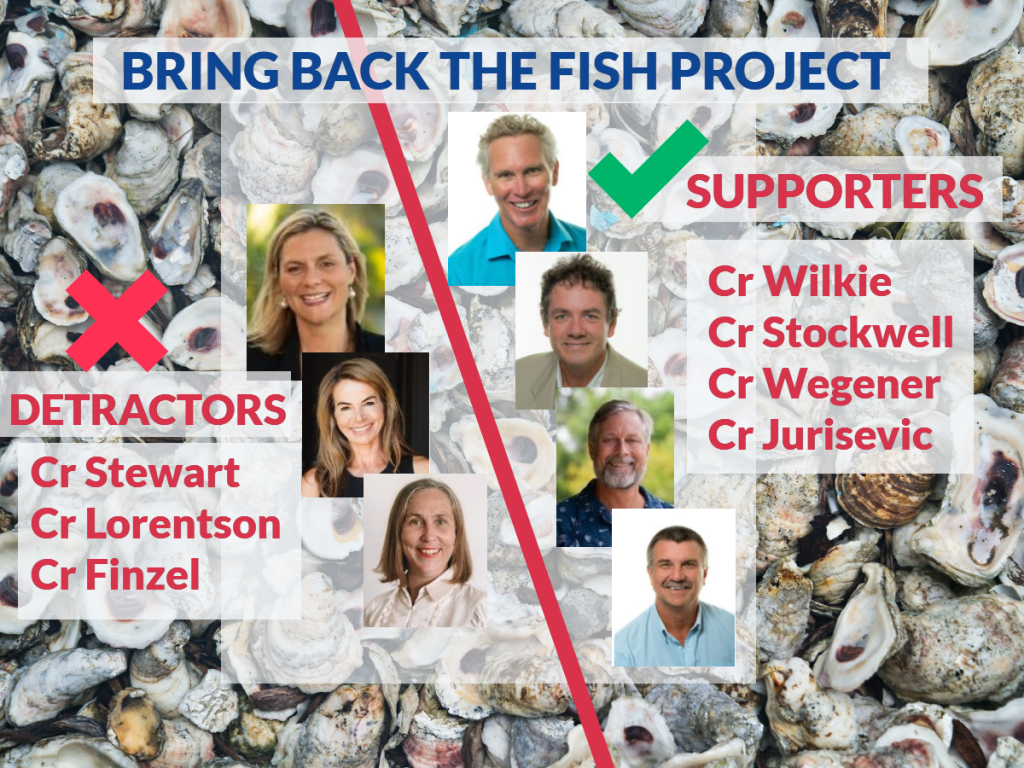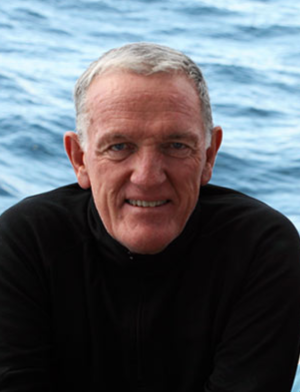In the lead up to the 2020 Noosa Council election, the Bring Back the Fish project strangely, unexpectedly emerged as a political issue.
Despite delivering environmental benefits to the long neglected river and lakes system and with a 2:1 subsidy for rate-payer contribution, a month before the election Mayoral candidate Clare Stewart declared the project a failure.
A month later she was elected Mayor by just over 300 votes, then maintained her opposition, voting against the project on six occasions at Council meetings over the next two years. Each time she was supported by Councillor Lorentson and four times by Councillor Finzel.
Nevertheless, with majority support from Deputy Mayor Frank Wilkie, and Councillors Jurisevic, Wegener and Stockwell, the project went ahead. Elsewhere around Australia, similar reef building projects were unanimously embraced by local councils with strong community support.

Now a survey of Noosa’s reefs nine months after their construction shows healthy initial progress vindicating the vision of the project’s original proponents – the Noosa Parks Association and the Thomas Foundation – and their supporters including the Noosa Biosphere Reserve Foundation, the Noosa Integrated Catchment Association, The Nature Conservancy, Environmental Service Professionals (ESP) and the four Noosa Councillors.
Consistent oyster settlement has taken place at the four reefs, with settlement of more than 800 oysters per square metre at the Goat Island reef – a result described as ‘dramatic’ by reef managers. As well there has been an increase in fish species and families. Nudibranchs, anemones, octopus, have all been recorded, some using the reefs for shelter or food, others taking up residence. While there may be future challenges for this long-run project, initial progress is good,
Yet in February 2020 – influenced by a few who felt their families were being unfairly blamed for historical environmental damage to the river and over-fishing of prawn stocks – Ms Stewart was reported as saying:
“There is a view we should not be dumping dead oyster shells from other systems into our river. Residents are disgusted at the blatant and disgraceful waste of ratepayer dollars.
“Many of those residents who have discussed this with me are of the opinion that the dead oyster shell fiasco was doomed to fail. People who are experienced with the live oyster and fish populations in the river will tell you that dead oyster shells are simply that … dead shells. They have no life and they attract no life.”
Yet studies show oyster shells are the preferred settlement material for juvenile oysters. From its extensive experience, including in Chesapeake Bay and New York Harbour, The Nature Conservancy incorporates cleaned oyster shells collected from restaurants in substrate when restoring reefs.
Studies also show that a hectare of rebuilt oyster reef filters 2.7 billion litres of water annually, removes 166 kilograms of nutrient pollution and produces 375 kilograms of new fish.
In 2013 The Thomas Foundation provided seed funding for TNC’s Great Southern Seascapes (GSS) initiative for the restoration of degraded bays and estuaries in Australia. Reef restorations were central and Bring Back The Fish was integrated into GSS. In Noosa, high school student participation was successfully encouraged. You can see a film here of one student’s engagement – The Oyster Gardener : ABC iview.
The Kabi Kabi’s traditional links to the reefs have been reinstated, with a smoking ceremony at Tewantin and naming the reefs after deceased spiritual leader Huon Mundy.

With GSS’s success and embrace by local communities, the Federal Government allocated $20m for Reef Builder grants, with $1.2m ear-marked for Noosa.
Then-Mayor Tony Wellington said at the time: “This is a rare opportunity to work with the world’s most trusted conservation organisation on a major local project. With the $1.2 million being offered, and a philanthropic donation by the Thomas Foundation, we have an offer too good to refuse. The big winner here will be the Noosa environment.”
Noosa is recognised for its progressive environmental initiatives over 60 years, and now as a place fortunate enough to have its river system improving thanks to the Bring Back The Fish project.
As the endorsed LNP candidate for the seat of Noosa, will Ms Stewart continue to represent the handful of opponents of this world-class project to improve our river? Or will she join what I believe to be a huge majority of locals who are proud of what’s being achieved?

